-
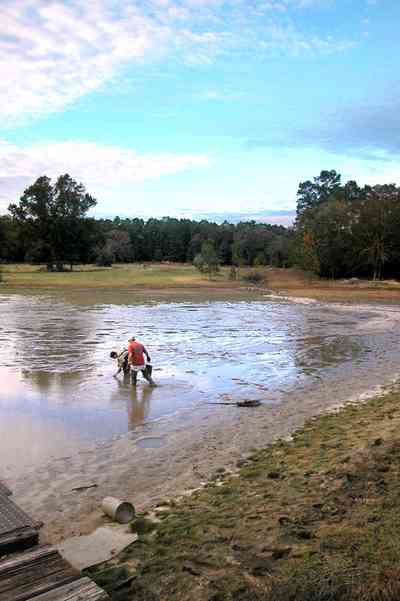
-
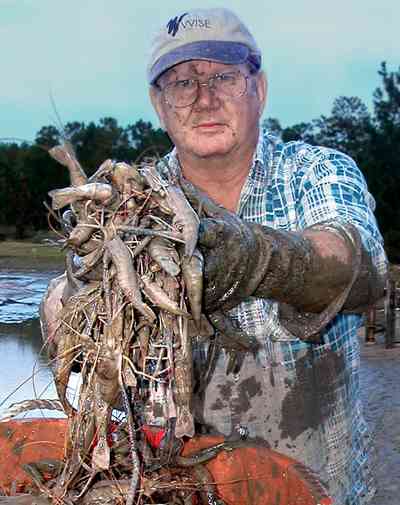
-
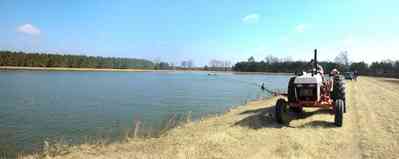
The catfish harvest begins by slowly seining the pond, beginning at one end with two tractors dragging the net, one on each side.
-
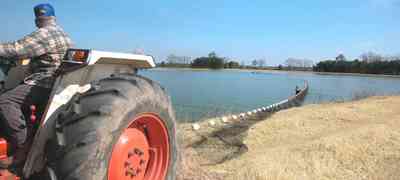
George drags one end of the seine net.
-

In this panorama of the pond, one man can be seen on right of the photograph. His job is to hold down the mud line so that the fish cannot escape under the seine net.
-
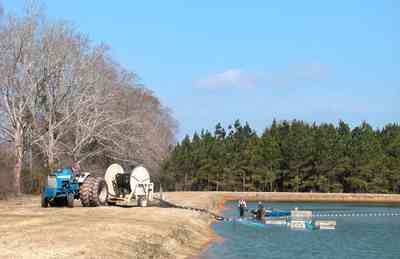
The larger tractor hauls a reel on which the seine net is slowly rewound.
-
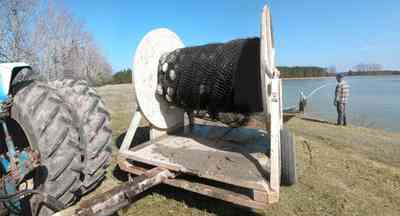
George Carpenter watches the seine net gradually close a small circle on the west bank of the pond.
-

The two harvesters in the lower frame are attaching "the sock" which is used to grade the fish.
-

The fish are contained in a narrow area, defined by the buoys on the seine net.
-

The trapped catfish swirl in the muddy water of the seine net.
-
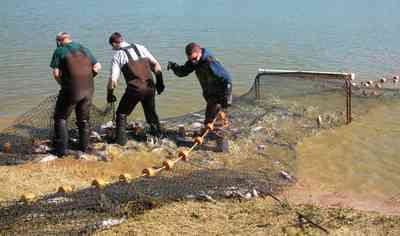
The fish are being driven into the sock. Small fish can escape through the netting while catfish 3 pounds and above remain in the sock. The grading process takes about 24 hours.
-
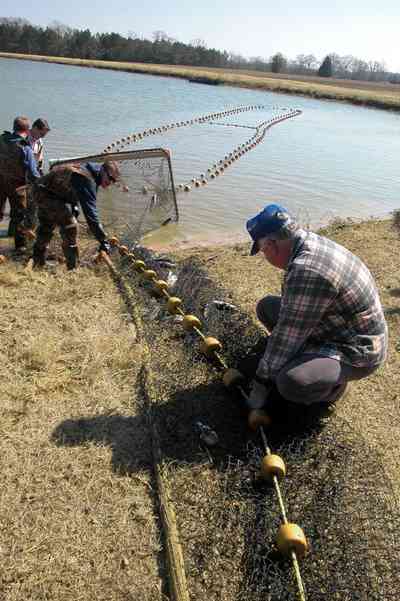
George rescues catfish that are caught in the seine net..
-
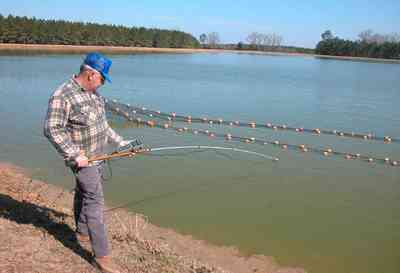
George is measuring the oxygen content of the water. This is an important task done as many as four times during a 24-hour period. The water is aerated at critical times. The sock will remain in place for 24 hours while the small fish escape the net.
-
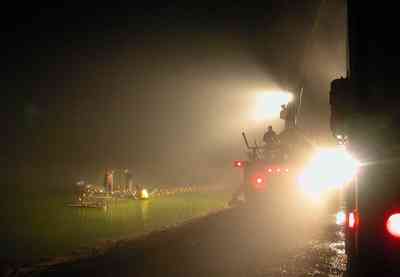
After the fish have graded themselves, the harvest begins. It usually takes place at night. The fish travel better at night and arrive at the processing plant early in the morning. There are six live wells on the truck that are injected with oxygen, ensuring that the catfish will arrive in excellent condition.
-
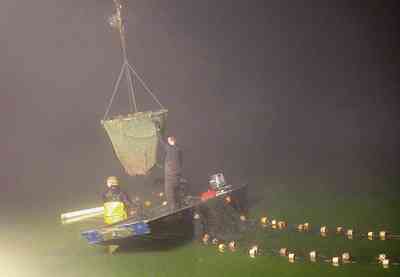
The loading basket has a trap door in the bottom.
-
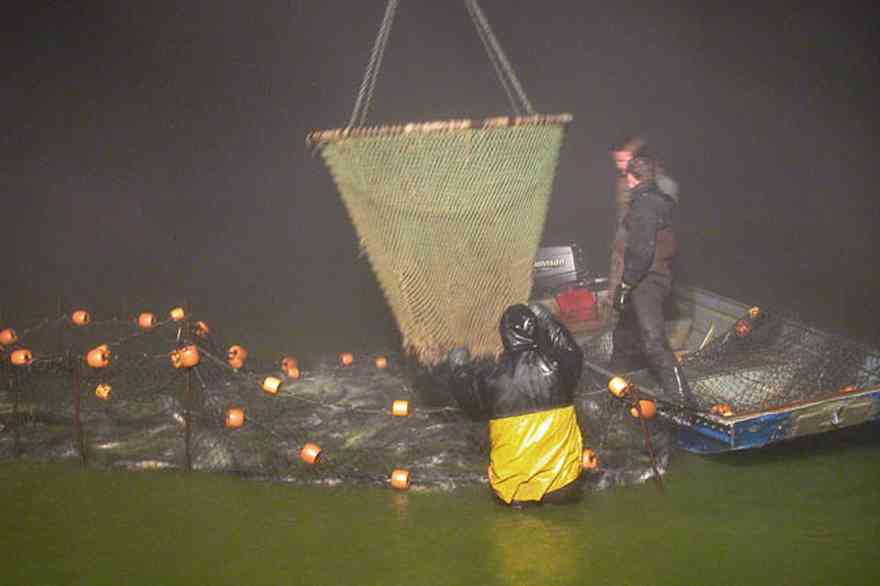
The basket is lowered into the teeming mass of catfish.
-
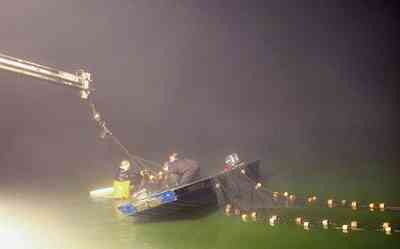
A boom truck will pick up the basket and load the fish into live wells on the truck.
-
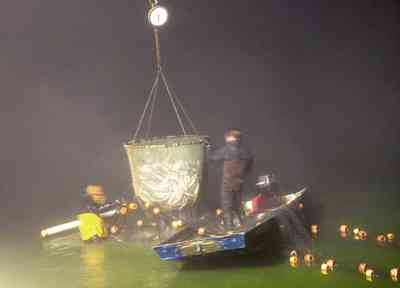
There is about 3,500 pounds per basket or 1,167 fish are retrived with each scoop.
-
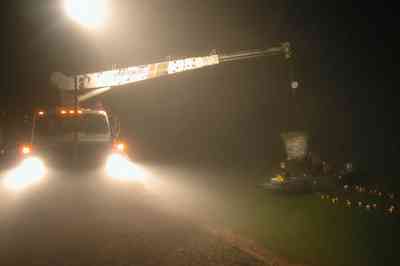
There are no chemicals used in the pond. it is a totally controlled environment. A sample fish is sent to the processing plant for assessment. Tasters at the plant decide when the fish are ready for harvest. A select few fish from each load are ground up and anaylzed for chemicals by the USDA.
-
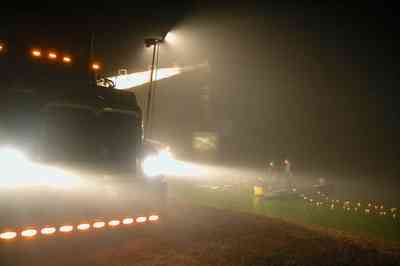
The taste of the fish depends on the quality of feed and water conditions. With the depletion of fish in the sea, catfish farming is becoming a growing industry.



 The catfish harvest begins by slowly seining the pond, beginning at one end with two tractors dragging the net, one on each side.
The catfish harvest begins by slowly seining the pond, beginning at one end with two tractors dragging the net, one on each side. George drags one end of the seine net.
George drags one end of the seine net. In this panorama of the pond, one man can be seen on right of the photograph. His job is to hold down the mud line so that the fish cannot escape under the seine net.
In this panorama of the pond, one man can be seen on right of the photograph. His job is to hold down the mud line so that the fish cannot escape under the seine net. The larger tractor hauls a reel on which the seine net is slowly rewound.
The larger tractor hauls a reel on which the seine net is slowly rewound. George Carpenter watches the seine net gradually close a small circle on the west bank of the pond.
George Carpenter watches the seine net gradually close a small circle on the west bank of the pond. The two harvesters in the lower frame are attaching "the sock" which is used to grade the fish.
The two harvesters in the lower frame are attaching "the sock" which is used to grade the fish. The fish are contained in a narrow area, defined by the buoys on the seine net.
The fish are contained in a narrow area, defined by the buoys on the seine net. The trapped catfish swirl in the muddy water of the seine net.
The trapped catfish swirl in the muddy water of the seine net. The fish are being driven into the sock. Small fish can escape through the netting while catfish 3 pounds and above remain in the sock. The grading process takes about 24 hours.
The fish are being driven into the sock. Small fish can escape through the netting while catfish 3 pounds and above remain in the sock. The grading process takes about 24 hours. George rescues catfish that are caught in the seine net..
George rescues catfish that are caught in the seine net.. George is measuring the oxygen content of the water. This is an important task done as many as four times during a 24-hour period. The water is aerated at critical times. The sock will remain in place for 24 hours while the small fish escape the net.
George is measuring the oxygen content of the water. This is an important task done as many as four times during a 24-hour period. The water is aerated at critical times. The sock will remain in place for 24 hours while the small fish escape the net. After the fish have graded themselves, the harvest begins. It usually takes place at night. The fish travel better at night and arrive at the processing plant early in the morning. There are six live wells on the truck that are injected with oxygen, ensuring that the catfish will arrive in excellent condition.
After the fish have graded themselves, the harvest begins. It usually takes place at night. The fish travel better at night and arrive at the processing plant early in the morning. There are six live wells on the truck that are injected with oxygen, ensuring that the catfish will arrive in excellent condition. The loading basket has a trap door in the bottom.
The loading basket has a trap door in the bottom. The basket is lowered into the teeming mass of catfish.
The basket is lowered into the teeming mass of catfish. A boom truck will pick up the basket and load the fish into live wells on the truck.
A boom truck will pick up the basket and load the fish into live wells on the truck. There is about 3,500 pounds per basket or 1,167 fish are retrived with each scoop.
There is about 3,500 pounds per basket or 1,167 fish are retrived with each scoop. There are no chemicals used in the pond. it is a totally controlled environment. A sample fish is sent to the processing plant for assessment. Tasters at the plant decide when the fish are ready for harvest. A select few fish from each load are ground up and anaylzed for chemicals by the USDA.
There are no chemicals used in the pond. it is a totally controlled environment. A sample fish is sent to the processing plant for assessment. Tasters at the plant decide when the fish are ready for harvest. A select few fish from each load are ground up and anaylzed for chemicals by the USDA. The taste of the fish depends on the quality of feed and water conditions. With the depletion of fish in the sea, catfish farming is becoming a growing industry.
The taste of the fish depends on the quality of feed and water conditions. With the depletion of fish in the sea, catfish farming is becoming a growing industry. One Tank of Gas
One Tank of Gas